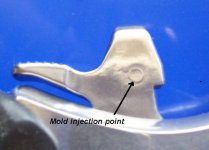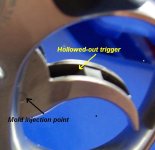I know of automobile connecting rods that are made in a powdered metal (PM) process, which uses similar materials and processes as MIM with some differences.
Some differences between MIM and PM are:
1. In the molding, there is no wax in the conventional powder metal (PM) process. That means the metal powder is dropped into a die cavity, a top die comes down and compresses the powder into a "green" part - fragile just like MIM, but the powder is held in its shape by being mechanically compressed, not injected with a binder like wax, like MIM.
2. In the sintering, PM parts don't shrink 30%, again due to the lack of that binder in the MIM process. Depending upon the PM formulation, the parts either shrink a tiny bit, expand a tiny bit, or stay the same size in the sintering.
In the sintering, each part's tiny metal particles touch other tiny metal particles, and all these contact points 'weld' together, giving the MIM and PM parts their strength. Both could be compressed in a secondary operation called 'sizing' to further densify the parts, and / or close up some of the tolerances as needed. A heat treat process can be added to remove stresses. Polishing, plating, and machining can also be added.
The biggest complaint of MIM and PM is usually due to the porosity. Each part has millions of tiny particles that contact other particles in a weld, and those parts also have gaps between them also. Connect enough gaps and you get what looks like a crack, and can be a weak point.
Advances in the past couple of decades allow producers to make stronger parts - above the strength required for storm window cranks, for example - so that PM parts can replace drive gears in power tools and engine cam gears, for example, ABS rings on everything, and connecting rods. In the case of the connecting rods, the one PM company that I know makes them with a proprietary process that makes them strong enough to do the job.
I am familiar with the MIM process but not the extent of the parts' usages - except of course gun parts. I do know the PM process and where those types of parts are used. I think MIM triggers and hammers will do the job just like machined or stamped metal parts, under normal use conditions.
google "Powdered Metal parts" and "Metal Injection Molding" and you will see videos and get more info than you will ever need.


